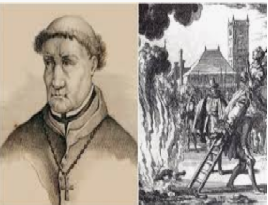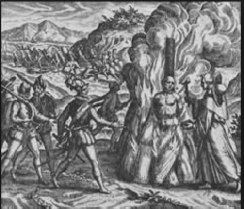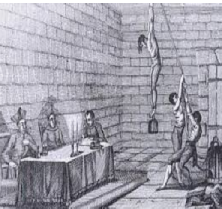|
PART 1 T O P I C |
|
|
|
|
|
|
|
|
|
|
|
|
|
|
|
|
|
|
|
CLICK BUTTON |
|
|
|
|
|
|
|
|
|
|
|
|
|
THE INQUISITION AND THE |
|
|
|
|
JewishWikipedia.info
It was widely accepted that the Inquisition existed only to rob people, as they openly affirmed (Kamen, The Spanish Inquisition, p 150). Both rich and poor knew that it was the rich who were most at risk. The fact that the Inquisition funded itself from the property it confiscated meant that it burned people on commission. Individual inquisitors also funded themselves, acquiring great wealth during their careers. Some inquisitors were known to have fabricated evidence in order to extort money from their victims, but even when discovered they received no punishment. Similarly their staff of helpers, called familiars, were free to commit crimes without fear of punishment by the secular courts. After 1518 this was formalised. Familiars enjoyed immunity from prosecution similar to benefit of clergy or modern diplomatic immunity. This provided another cause of popular scandal, along with their exemption from taxation .
The activities of the inquisitors were resented by all sections of society, and the papacy was obliged to interfere from time to time, although the inquisitors were powerful enough to ignore it on many occasions. Pope Sixtus IV issued a bull on the 18th April 1482 protesting that
in Aragon, Valencia, Mallorca and Catalonia the Inquisition has for some time been moved not by zeal for the faith and the salvation of souls, but by lust for wealth, and that many true and faithful Christians, on the testimony of enemies, rivals, slaves and other lower and even less proper persons, have without any legitimate proof been thrust into secular prisons, tortured and condemned as relapsed heretics, deprived of their goods and property and handed over to the secular arm to be executed, to the peril of souls, setting a pernicious example, and causing disgust to many.
THE GRAND INQUISITOR’S MANUAL
by Jonathan Kirsch pp117-121
Both the compulsory pilgramage and the wearing of heretic’s crosses put the victim at risk of financial ruin. But the Inquisition was not always content with such indirect methods and the property of a man or woman was at risk too. The inquisitor might order that a heretic’s house be torn down and everything else the heretic possessed be confiscated and sold, thus reducing the family to poverty and disinheriting the children. The inquisitor might impose monetary fines on the convicted heretic or, if the heretic was already dead, on his or her children and grandchildren. Indeed, the profit motive was one of the great engines of the Inquisition, and the opportunity to turn heresy into gold sometime' resulted in a free-for-all among the inquisitors as well as among popes and bishops, kings and princes, all of them scrambling for a share of the loot.
“By confiscation the heretics were forced to furnish the means for their own destruction,” writes Lea, whose words apply with equal accuracy to the looting of the victims of later persecutions in Nazi Germany and Stalinist Russia. “Avarice joined hands with fanaticism, and between them they supplied motive power for a hundred years of fierce, unremitting, unrelenting persecution, which in the end accomplished its main purpose.” To be sure, the destruction of a house on the orders of the Inquisition profited no one. Still, the early and more principled inquisitors regarded the house where a perfectus lived—or where the last rite of the consolamentum had been conducted for a dying Cathar—as something so tainted that it could no longer be used by good Christians. That was why, for example, the inquisitor’s decree might prohibit the construction of a new house on the blasted plot of ground where the old house had stood. Even the houses of fautors — those good-hearted souls who did nothing more than shelter a friend or relation who was accused of the crime of heresy—could be reduced to rubble on the orders of the inquisitor. And, according to law, the civil magistrates were commanded by the Church to carry out an order for destruction within ten days after it was handed down by an inquisitor.
When the inquisitors turned to the practical problem of paying the bills however, it occurred to them that the property of an accused heretic could be put to better use. The materials from a destroyed house, for example, might be retrieved and recycled for the construction of a worthy structure like a hospital or convent. Or the inquisitors themselves might commandeer the house of a convicted heretic for use as a dormitory or prison. Eventually, the Inquisition came to realize that the house of a convicted heretic was not so hateful that it could not be used to turn a profit. Thus began what Lea calls, in a characteristically colorful turn of phrase, the “saturnalia of plunder” that was the highly profitable by-product of the war on heresy.
To increase the cash flow of the Inquisition, some inquisitors offered to commute the harsher sentences in exchange for a cash payment; thus did the inquisitors of Toulouse extract enough money from twelve wealthy heretics to build the cathedral of Lavaur. At other times and places, the inquisitors often behaved more like arbitrageurs and speculators than crusaders against heretical depravity. Lands, houses, money, and other property were seized and inventoried as soon as someone came under suspicion of heresy, in prevent the suspect from hiding or selling the property before a formal order of forfeiture was issued. To protect the interests of Church and state in the plunder, the royal tax collectors in France placed a mortgage against the property of an accused heretic and thus trumped any claims that might be made by his wife and children or a stranger who sought to buy the property from the accused heretic.
Confiscation and forfeiture by order of the Inquisition created a whole new set of uncertainties in business transactions. Sellers of property in the city of Florence, for example, were obliged to post a bond against the risk that the buyer might take up residence in a house and later find out that it was the subject of a new or long-simmering inquisitorial proceeding. The Inquisition was so pervasive and so unsettling that, Henry Charles Lea insists, it literally changed the history of Europe. Commerce and industry languished in the lands where it operated with the greatest authority, such as Italy, Spain, and southern France, argues Lea, and flourished in places like England and the Netherlands, where it was toothless or nonexistent.
To make sure that the possessions of a convicted heretic were thoroughly ransacked, the Inquisition also imposed fines on its victims, sometimes as a form of penance and sometimes as the price for buying the commutation of an even harsher punishment. In some precincts, the obligation to wear the crosses of infamy was accompanied by a fine of five or ten florins of pure gold to “defray the expenses of trial.” At first, Pope Innocent IV raised a pious objection to the imposition of fines “to the disgrace of the Holy See and the scandal of the faithful at large,” and he later decreed that fines were forbidden in favor of other forms of penance. But the operating expenses of the Inquisition were so considerable that the popes soon found themselves compelled to approve the imposition of fines for “pious uses,” which included the payment of the inquisitors themselves.
Whenever the supply of living heretics with available assets ran low, Inquisition turned to the prosecution of dead ones. Since a “defunct" defendant was unable to protest—and the passage of time since his death meant that witnesses and evidence were sparse or wholly unavailable -- the proceedings “against the memory” of dead heretics required even less evidence and less effort than the trial of a live one. The real motive was clearly the confiscation of the dead heretic’s fortune, and the grisly practice of exhuming and prosecuting corpses, however offensive it might have been the general populace, presented an opportunity for the Inquisition to turn a risk-free and effortless profit.
As we have seen, the Inquisition was permitted to accuse and condemn dead heretics for crimes dating back at least forty years and, in some cases a full century. The period ran not from the date on which the alleged crime was committed but when it was detected, which further extended the inquisitors long reach. As a result, anyone who had done business with someone later accused of heresy—and anyone who had inherited property from the dead heretic—was always at risk that the inquisitor would claim money or property that had passed out of the hands of the dead heretic long ago.
Thus, for example, Fra Grimaldo, the inquisitor of Florence, prosecuted the “memory” of a wealthy and influential Florentine nobleman more than sixty years after the latter’s death, belatedly charging the deceased with having submitted to the consolamentum on his deathbed and then proceeding against his surviving grandchildren. None of the descendants of the dead heretic was actually accused of heresy; indeed, one of his grandchildren wan a friar and another served as the prior of a church. But the property that had once belonged to the dead man was seized by the Inquisition, and his grandchildren who served the Church were defrocked on the grounds that the descendants of a heretic down to the second generation were ineligible to hold clerical rank.
Now and then, some high-minded churchman might address the plain injustice of confiscation and seizure of property. Suppose, for example, that the wife of a condemned heretic was herself a good Catholic; should she be reduced to poverty, too? Under canon law, the dower—a portion of the husband’s property set aside for the support of his widow in the event of his death was held to be exempt from confiscation, but only if the wife could prove to the satisfaction of the Inquisition that she did not know her husband was a heretic when they were married. Moreover, if she later learned that her husband held heretical beliefs, she would forfeit the exemption if she had failed to report her spouse to the Inquisition within forty days if the wife was entitled to draw on the dower for her livelihood the right ended on her own death. The children of a heretic were disinherited, and so the dower was confiscated by the Inquisition on the death of their mother.
Any concern for widows and orphans that might stir the conscience of a principled inquisitor was usually outweighed by more practical considerations The Inquisition was a high-overhead operation, and money was always needed for the support of the inquisitors and their servitors, for the building and running of prisons, and even for such incidentals as the yellow cloth for the crosses worn by repentant heretics and the kindling for the fires on which unrepentant heretics were burned alive. As the war on heresy ran out of Cathars and Waldensians, the Inquisitions restless search for victims came to be driven by sheer greed. “But for the gains to be made out of fines and confiscations, its work would have been much less thorough,” observes Lea. “It would have sunk into comparative insignificance as soon as the first frantic zeal of bigotry had exhausted itself.”
The plunder prompted a whole new conflict between Church and state. In theory, the income from fines, commutations, and the sale of confiscated property was to be divided in equal shares: one-third to the municipal government of the town where the inquisitors had set up their tribunal, one third to defray the expenses of the inquisitors who had issued the order of confiscation or imposed the fine, and the rest to the Church for the use of the local bishop and to defray the general operating expenses of the Inquisition. But the actual division of the spoils varied from place to place. In France, the forfeited property of convicted heretics belonged to the king, although he was expected to apportion some of the proceeds to the inquisitors at work in France and to the operating expenses of the inquisitorial prisons in his territories, including rations for the prisoners and wages for their guards. In Italy, by contrast, the Inquisition managed to keep its hands on so many of the spoils that it was self-supporting.
Money was also raised through the sale of Indulgences
An indulgence is the full or partial remission of temporal punishment for sins after the sinner confesses and receives absolution. Under Catholic teaching, every sin must be purified either here on earth or after death in a state called purgatory.
The first known use of plenary indulgences was in 1095 when Pope Urban II remitted all penance of persons who participated in the Crusades and who confessed their sins. Later, the indulgences were also offered to those who couldn't go on the Crusades but offered cash contributions to the effort instead. In the early 1200s, the Church began claiming that it had a "treasury" of indulgences (consisting of the merits of Christ and the saints) that it could dispense in ways that promoted the Church and its mission. In a decretal issued in 1343, Pope Clement VI declared, "The merits of Christ are a treasure of indulgences."
THE
INCREDIBLE
STORY OF THE JEWISH PEOPLE
WHAT ARE INDULGENCIES ?
The Berean Call 2008 (7.27)



FINANCING THE INQUISITION
